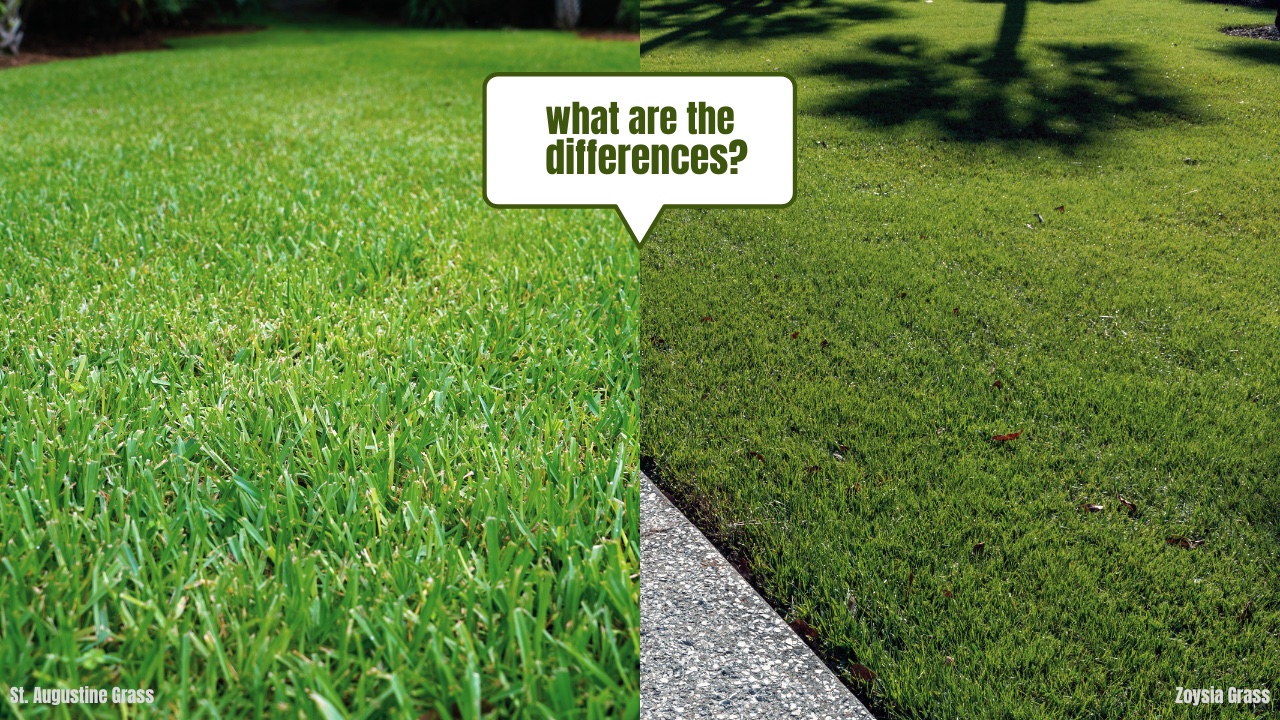Homeowners in the southern regions of the United States understand the struggle of maintaining a healthy lawn throughout the sweltering summer months. Planting warm-season grass like St. Augustine and Zoysia grass is the best way to sustain a lush, green lawn.
What are the differences between the two?
St. Augustine produces a dense, coarse, bluish-green turf, ideal for low-traffic lawns. Zoysia grows a thick, soft, emerald green turf suitable for high-foot trafficking areas, including lawns, parks, and golf courses. St. Augustine is more shade tolerant but requires more water and fertilizer.
St. Augustine and Zoysia grass both thrive in the warmer regions of the United States. Still, they have different appearances and growing requirements. We will discuss the most important differences to help you find the best variety for your lawn.

St. Augustine vs. Zoysia Grass: 9 Primary Differences
Warm-weather grass is ideal for warm-temperate regions like the Southern and Southeastern United States. While both St. Augustine and Zoysia grass are warm-season grasses, one variety may be more suitable, depending on where you live.
Here are the 9 primary differences homeowners need to consider before choosing St. Augustine or Zoysia grass for their lawn.
1. Appearance & Texture
St. Augustine grass produces a coarse-textured, bluish-green turf with folded wide, flat blades and blunt, rounded tips. Its low, creeping habit allows it to form an extremely dense, carpet-like turf, making it challenging for weeds to poke through.
Zoysia produces a soft-textured, medium-deep emerald green turf with long, thin, and fine blades. It is a low-growing variety with a dense root system, forming thick clusters of grass blades.
Characteristics | St. Augustine Grass | Zoysia Grass |
|---|---|---|
Appearance | Blue-green turf with wide blades | Emerald green turf with fine blades |
Texture | Coarse-textured | Soft-textured |
2. Growth Habit
St. Augustine grass produces thick, singular seed heads that produce small, white-brownish flowers. It only spreads through stolons (above-ground shoots) and lacks rhizomes (underground shoots). Zoysia grass spreads through stolons and rhizomes.
Characteristics | St. Augustine Grass | Zoysia Grass |
|---|---|---|
Growth habit | Stolons | Stolons and Rhizomes |
3. Ideal Uses
St. Augustine grass is mainly used for lawns and turfs with low foot traffic. It has a relatively poor wear tolerance and only holds up to normal lawn traffic.
Zoysia grass is a highly versatile species and among the most tolerant for foot trafficking. It is ideal for lawns, golf courses, athletic fields, and parks. However, its slow growth rate gives it a poor recuperative potential, and it may take long to repair damaged areas.
Characteristics | St. Augustine Grass | Zoysia Grass |
|---|---|---|
Uses | Low-traffic lawns | Lawns, golf courses, athletic fields, and parks |
4. Soil Preference
The soil classification and how much effort you are willing to put into improving it are vital factors to consider when choosing turf.
Characteristics | St. Augustine Grass | Zoysia Grass |
|---|---|---|
Soil type tolerance | Sand, loamy soil, and well-draining clay | Sand, loamy soil, and clay |
Drainage requirements | Needs proper drainage | More tolerant of poor drainage |
pH preference | 5.0 to 8.5 | 5.8 to 7.0 |
Salt tolerance | Excellent | Good |
Fertilization requirements | High Nitrogen requirements | Low fertilization requirements |
Both St. Augustine and Zoysia grass varieties perform well in a broad spectrum of soil types – sandy, loamy, and clay – if drainage and fertility are adequate. Compact, waterlogged clay soil can cause fungal diseases and prevent the grass from growing satisfactorily.
Both varieties thrive best in a loamy soil. However, St. Augustine grass tolerates sandy soil better than Zoysia grass. Zoysia needs more dark, rich, organic matter to thrive. St. Augustine and Zoysia are salt-tolerant lawn grasses suitable for landscape areas with saline soil. However, they cannot be irrigated with saltwater.
St. Augustine is a high-maintenance turfgrass and requires more fertilization than Zoysia grass. You can expect to fertilize St. Augustine grass with a nitrogen-rich fertilizer monthly on sandy soil and every 6 weeks on loam or clay soil during its growing season. Zoysia only needs nitrogen in summer if soil tests recommend it. (Related article: 7 Best Fertilizers For Healthy Zoysia Grass)
5. Temperature Preference
St. Augustine and Zoysia grass grow vigorously in warm temperatures of 80 to 95 degrees Fahrenheit and turn dormant in winter temperatures below 55 degrees Fahrenheit.
6. Sunlight Preference
St. Augustine and Zoysia grass are sun lovers; however, they tolerate shade better than most warm-season grasses. St. Augustine grass is the most shade-tolerant variety of all warm-season grass. However, it still needs 4 to 6 hours of sunlight daily to thrive.
Zoysia grass thrives best in full sun, requiring 6 to 8 hours of sunlight daily. It will tolerate light to moderate shade, but the turf will be thinner in shady areas.
Characteristics | St. Augustine Grass | Zoysia Grass |
|---|---|---|
Sunlight requirements | 4 to 6 hours daily | 6 to 8 hours daily |
7. Water Needs
St. Augustine grass is susceptible to drought year-round.
Expect to provide ¾ to 1 inch of water every 5 to 10 days during its growing season or when the lawn appears dry and shows drought stress – bluish-gray color, folded leaves, and footprints. Although dormant in winter, St. Augustine grass still needs to be watered periodically to prevent drought stress and turf loss.
Zoysia grass is extremely drought-tolerant, requiring minimal supplemental irrigation to remain emerald-green and actively growing during the summer. However, it may need watering during prolonged dry periods.
Characteristics | St. Augustine Grass | Zoysia Grass |
|---|---|---|
Drought tolerance | Low | Extremely high |
Water requirements | ¾ to 1 inch weekly | 1 inch weekly in prolonged droughts |
8. Growth Rate
St. Augustine grass is a rapid-grower, perfect for fast-spreading, lush lawns. Once planted, it takes between 7 and 14 days to establish and begin spreading.
You can expect your desired lawn area to be fully covered within one growing season, given the proper spacing of St. Augustine sod or plugs.
Planting a Zoysia lawn takes patience and hard work. The seeds take 21 to 28 days to germinate, and sods or plugs take between 7 and 14 days to establish. Zoysia grass will start spreading within 3 months of planting. However, it spreads very slowly and can take up to three years before your lawn is fully established.
Characteristics | St. Augustine Grass | Zoysia Grass |
|---|---|---|
Growth rate | Rapid grower | Slow grower |
Estimated wait time till lawn is fully established | 1 growing season | Up to 3 years |
9. Costs
According to HomeGuide sod installation costs, St. Augustine sod costs between $135 and $360 per pallet or $0.30 to $0.80 per square foot, depending on the variety and order size. In comparison, Zoysia sod costs around $130 and $450 per pallet or $0.28 to $0.80 per square foot.
Final Thoughts
Comparing the primary differences between St. Augustine and Zoysia grass ensures you choose the variety that suits your climate, maintenance preferences, budget, and personal taste. (Related article: St. Augustine vs Bermuda Grass: Which is Better?)

